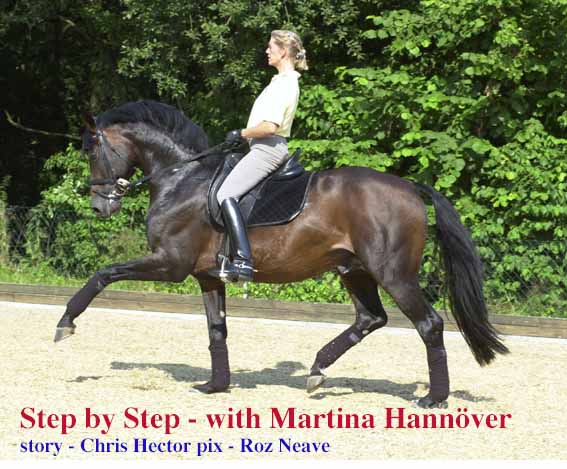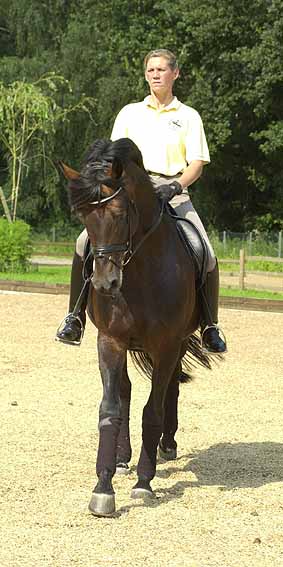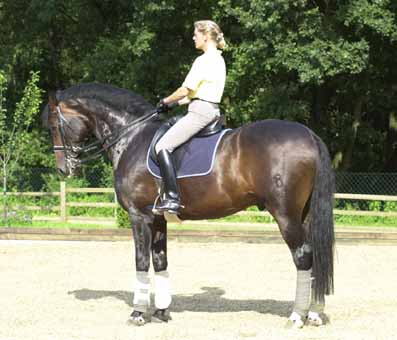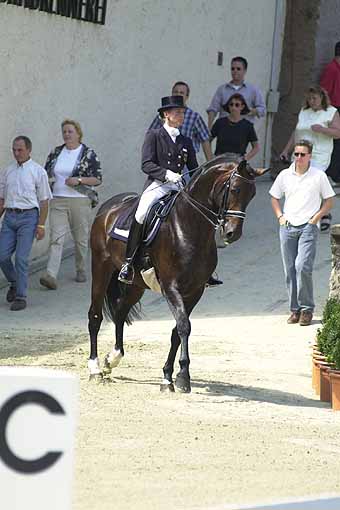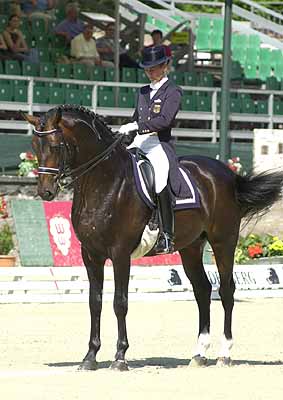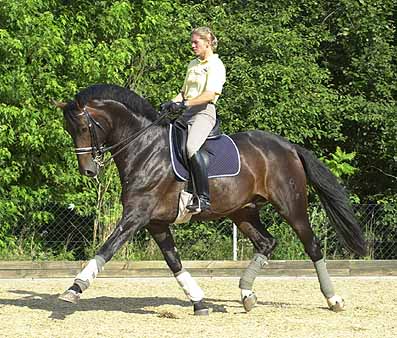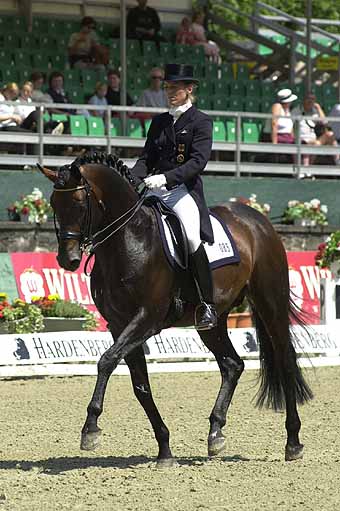Let’s get away from the ‘principles’ and ‘theoretics’ I said to my friend Martina Hannöver-Sternberg, let’s down to the nitty gritty, all those individual bits of a test that make up a winning score.
‘Sure,’ said one of the most positive people in the world, ‘let’s do it, and let’s start at the start…’
MAKING A GOOD ENTRY
To make a very good entry in a dressage test, starts at home. With all the normal work there is one big rule: take care to stay away from the wall. That is the way you get the horse balanced for all the movements, and you have to train it with all horses.
For the entry I think a little bit of shoulder fore so that I can feel that the horse is straight, that you have the inside hind leg under, jumping under. Keep control with the outside leg. Actually the most important thing is that the horse keeps in front of you on the centre line.
Young horses can easily get a little tense in the back, and come up and behind your aids, so you have to train to overcome this at home.
To make a nice halt you have to put in many half halts before, then make a soft half halt. That’s how I prefer it. I see some very hard stops, and the horse stands on all four legs, but for me it is much nicer if you come out of the canter and you have one leg in front, from the canter stride, and you make a halt, and the other leg comes and they stand.
I teach my horses to stand square all the time. Even if I am tightening up the girth, or I have stopped to talk to somebody. I am always trying to train the horse so that it knows that under the rider it always has to stand on all four legs every time I make a halt. When you are first on the horse it is very easy to do it, sometimes when the horse is tired after work they don’t do it so easy then. They are not under themselves like they were when you started to ride them because they are a little weaker – then you just do what you can to bring their legs up a little.
You have to teach the horse to go forwards or sideways from your leg. Always make the halt square by going forward, never by backing, never – if you do that the horse stands with the legs out, and he is not in front of you any more, the back goes out and the horse is not with you.
Ratino H and Martina ride off the track to develop straightness
Make them stand square but don’t worry about a centimetre here or there. It depends on the age of the horse, with an older horse you want a really square halt for a 9, but with a younger horse, just get the legs under. For a halt you must have control on both reins. If you can’t give them half halts on both reins, if the horse is not accepting the half halts, then they move their front legs, and they are not square either.
When I ride a horse like Donnerbube, he is super when you don’t give him too much work in the warm up. He really needs to take in the atmosphere. I just give him a short warm up in the practice arena, and then let him stand still, and he stands there and he gets used to the atmosphere, but when I start trot he has to react right away. So he can relax but he also must have the button on.
It is really really important that the rider looks good coming down the centre line. If the horse gets a little down with his neck, down with his poll, and he gets you a little bit out of the saddle, especially when you are a bit nervous, then you are not sitting on your bottom any more, so you start your test terribly. The horse is not under you like he was in the warm up arena any more. If can also happen because the horse gets a little tense as he comes into the arena because he knows what is starting. You have to sit back, sit straight, shoulders up, look straight, and keep the horse in front of you and under.
You should do a smile for the judges but I don’t think I always do it. I am always trying to smile, but I think I am so concentrated that I miss it.
Got that all worked out – now Tina is going to take you through the next step on your way to that super test…
Work on a nice square halt starts at home…
TROTTING OUT OF THE HALT AND THROUGH THE CORNER
This is something you should also train at home, and in the warming up, making sure your bottom is in the saddle, and the horse is listening. At home I always come out of halt in trot, not in canter or walk, so I don’t confuse them. In every test, you come in trot.
To have a nice trot depends on the horse. Some horses swing more if you ride them a bit softer and let them swing over the body – some horses need more pressure on the centre line – you get them a little extended on the centre line – then bring them back to make the turn when you come to the short side and the corner. Sit straight, put your inside shoulder back, control the horse with the outside rein, not pulling with the inside rein because if you do that then most of the time they get too deep in the poll. Get them in front of your inside leg because the next thing is the extended or medium trot and you have to have them in front of you.
You are giving the horse half halts all the time, and your outside leg has control of the outside hindleg. It is a bad fault if the outside hindleg goes out in the turns. You have to look where you are going because if you sit straight and look where you want to go, then you automatically sit in the right position.
You should try to collect the horse in the corner, so that you can make a nice extension. At home it is good to ride voltes to make sure you get the bend through the corner. That is hard for me because I am not so good with voltes because I train so much away from the wall to get the balance.
Donnerbube takes in the atmosphere at Norten Hardenberg and still makes a great entrance…
I also try to train the rider to feel where the hind legs are going, and to work on that transition from the straight line to the circle or volte and asking for the same bend through the poll and the neck and the ribs. This movement is in every test. It starts on the centre line, turn, corner. I start it with my three-year-olds, straight then making him bend to the one side, making him straight, change rein; this is a basic gymnastic exercise.
While I ride away from the wall a lot of the time, before a show I am also training corners. The thing is to keep the horse really balanced and the rider listening to the hind legs and where they are going – because this will lead to the later movements like the half pass where if you feel where the hind legs are going then you know if you have to push a little bit more with the left leg or with the right leg. If you don’t train this – then it is just like riding a bicycle through the corner!
The first corner is really important for the rest of the test, especially in the Grand Prix you have to have the horse collected in every corner like you had in the first corner, then you can make a nice test.
And the last movement for this month – the really exciting bit:
ACROSS THE DIAGONAL IN BIG TROT
Even when the test says ‘medium’ trot for the first diagonal most riders ride extended – I haven’t seen a horse run away in the test in my life so you might as well go for it. At this stage all the horses are a little bit behind you because of all the atmosphere, and also the rider is a little bit shy first thing.
You don’t want to make a mistake on that first diagonal; you try to make it really nice. You have to sit straight, the horse into your hand, feel with both seat bones and with your tummy that everything is straight – because when you are straight the horse can be straight also.
To get the big trot it is like everything else, you have to train for it. Some horses don’t have such a great extended or medium trot, but you can train it as the horse gets stronger.
Take Donnerbube, he had a nice big trot when he was four and five but when he came to Prix St Georges and Intermediaire I, he wasn’t enough on the hind legs, carrying the weight – now he gets better and stronger, so I figure I was doing the right work with him.
Every horse is different; they all have a different way of going. With Donnerbube he was really talented in piaffe, so over winter I was training a little bit in piaffe, where he has to sit down, and really carry himself – just a few steps, then trot out again, back from the trot, into a few steps piaffe, back to trot again, and it made him so much more forward. He wasn’t stressed, he was happy, and he really started to come out of the piaffe with such a good trot.
With a horse like Rescue Me, I do a lot of canter work because it is much easier for him in canter – we do a circle in canter, a little travers, working in collected canter, to jump in a collected way, not just jumping short, and with the bend around my inside leg, then his inside hind leg jumps more through, and then into trot out of that. He has not such a big trot and it is really hard for him. He will just get longer and longer if you train the extended trot all the time; better to get him really short in the canter and a little bit sharp and get the trot from there.
Some horses naturally have a big trot and they can sometimes go a little unevenly. With horses with a big trot, I don’t train the extended trot so much, I just train the transitions: a few metres really extended, then getting back again. It is so hard on their bones, especially the big movers – it is like a jumping horse, they can only make so many jumping tests, and a dressage horse can only do so many extensions – you have to take care of their legs and their tendons. If they already have that big trot, you have to take care of it.
Some riders lose marks because they finish their extended trot, or extended canter too early, before they get to the track – and I think that is perhaps because they start their diagonal too fast. Always when you come into the corner, the horse starts to come back a little by himself. It is better to start nice and pretty, and at X you really put your foot down. Train it at home. I train the halt and trot off, and then when I take them a little bit more into the corner, then they know they are going across the diagonal. Take them out there and let them open up. It is not just that they are super how they move their legs in extension, it is also how they grow up in front. They listen to your seat to go forward, and then with the half halt they come back to you right at the end of the diagonal.

